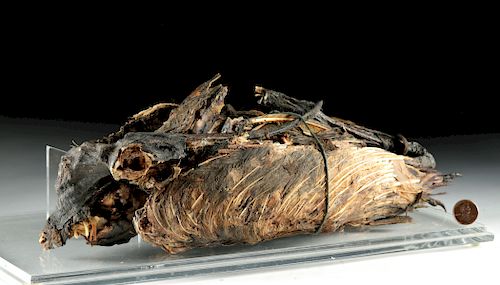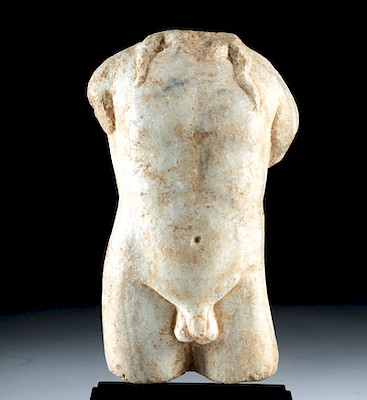Egyptian Mummified Ibis - ex-Royal Athena
Lot 3b
About Seller
Artemis Fine Arts
686 S Taylor Ave, Ste 106
Louisville, CO 80027
United States
Selling antiquities, ancient and ethnographic art online since 1993, Artemis Gallery specializes in Classical Antiquities (Egyptian, Greek, Roman, Near Eastern), Asian, Pre-Columbian, African / Tribal / Oceanographic art. Our extensive inventory includes pottery, stone, metal, wood, glass and textil...Read more
Estimate:
$2,500 - $4,000
Absentee vs Live bid
Two ways to bid:
- Leave a max absentee bid and the platform will bid on your behalf up to your maximum bid during the live auction.
- Bid live during the auction and your bids will be submitted real-time to the auctioneer.
Bid Increments
| Price | Bid Increment |
|---|---|
| $0 | $25 |
| $300 | $50 |
| $1,000 | $100 |
| $2,000 | $250 |
| $5,000 | $500 |
| $10,000 | $1,000 |
| $20,000 | $2,500 |
| $50,000 | $5,000 |
| $100,000 | $10,000 |
| $200,000 | $20,000 |
About Auction
By Artemis Fine Arts
Dec 5, 2018
Set Reminder
2018-12-05 10:00:00
2018-12-05 10:00:00
America/New_York
Bidsquare
Bidsquare : DAY 1 | Classical Antiquities & Asian Art
https://www.bidsquare.com/auctions/artemis-gallery/day-1-classical-antiquities-asian-art-3698
Day 1 of an important 2-day auction featuring ancient and ethnographic art from around the world. Egyptian, Greek, Roman, Viking, Near Eastern plus Asian Art from China, Japan, Thailand, Vietnam, Burma, India, more. Artemis Fine Arts info@artemisfinearts.com
Day 1 of an important 2-day auction featuring ancient and ethnographic art from around the world. Egyptian, Greek, Roman, Viking, Near Eastern plus Asian Art from China, Japan, Thailand, Vietnam, Burma, India, more. Artemis Fine Arts info@artemisfinearts.com
- Lot Description
Ancient Egypt, Late Period, ca. 712 to 300 BCE. A mummified sacred ibis. The bird's body is folded into a bundle and was once wrapped tightly in woven textiles, some of which remains - though most of the bird, from the head and neck to the thin, long legs and thick feathers, is exposed, darkened by the patina of the years. The mummy may have once had a bronze head attached to its front, which was common practice for these ibis mummies. This example that clearly contains the actual body of the bird may be rarer than you assume - recent research suggests that up to a third of Egyptian animal mummy bundles only contain partial animals or are even just bundled cloth, made by ancient embalmers to sell to gullible pilgrims. Comes in a plastic case. Size of bird: 5.85" W x 14" H (14.9 cm x 35.6 cm); size of case:
The ibis, an elegant, long-legged wading bird that lives along the shores of the Nile, was associated with the god Thoth and, later, the sage Imhotep. He was the god of wisdom and writing, and in worship to him ibises were ritually sacrificed, embalmed, and mummified before being buried in underground galleries. CT-scans on some of these mummies has revealed that many were fed posthumously. Their stomachs were removed during the mummification process, and, via an incision, a small parcel of food - mainly snails - was inserted them before they were carefully replaced in the bird's chest cavity. As shocking as it may seem, there were millions of these burials, many of which have been excavated at Saqqara, near Memphis, Egypt's ancient capital. Saqqara was a temple complex with a large system of catacombs underneath it. DNA analysis on other animal mummies leads us to believe that the animals were bred specifically to be sacrificed and mummified. Especially during the Late Period, the Egyptians seem to have been obsessed with ibis (and other animal) mummies, which, in the case of ibises, were used to gain Thoth's favor. A pious individual would go to the temple, pay a priest to intercede with Thoth for them, and the priest would mummify an ibis.
Provenance: private southern California, USA collection, acquired in the 1970s to mid-1980s
All items legal to buy/sell under U.S. Statute covering cultural patrimony Code 2600, CHAPTER 14, and are guaranteed to be as described or your money back.
A Certificate of Authenticity will accompany all winning bids.
We ship worldwide and handle all shipping in-house for your convenience.
#140955The remains are in very fragile condition and should be handled as little as possible. Some of the bones and feathers have separated from the main part of the body. Tied together with string. Remains of textile can be seen throughout. Leg has some kind of resinous coating on it that was likely applied at the time of mummification.Condition
- Shipping Info
-
All shipping is handled in-house for your convenience. Your invoice from Artemis Gallery will include shipping calculation instructions. If in doubt, please inquire BEFORE bidding for estimated shipping costs for individual items.
-
- Buyer's Premium



 EUR
EUR CAD
CAD AUD
AUD GBP
GBP MXN
MXN HKD
HKD CNY
CNY MYR
MYR SEK
SEK SGD
SGD CHF
CHF THB
THB

















